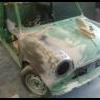
Timing And Co2 Settings For A Racing 998
#1

Posted 25 April 2012 - 06:33 AM
Armed with only a timing light, CO2 meter and a colortune, how would you go about getting the best bhp out of a "bog standard" 998cc engine?
I've read every technical article and David Vizard book known to man, but having never stuck a mini on the rollers I've got no timing or CO2 figures to aim at.
Based on the Haynes manual, it's supposed to be 8 degrees at 1,500rpm on a 99H engine, and Mr MOT would like the CO2 at 4.5% or less. We run vacuum advance on the dizzy. We also have to use an 'unbutchered' needle so have a selection of AAF, AAM, AAU, AAA etc for tinkering with thanks to that mintylamb web site.
If I listened to everyone at the track who had an opinion on the subject I'd get nowhere, so are there any tuners on here or people who have had cars tuned who could help with timing and co2 settings?
So can anyone give me some suggestions (I found an article by DV about using the colourtune to do your own rolling road, using the brake to hold the revs at 3,000, 4,000 etc, but I guess that's the easy bit once the timing is about right).
cheers
Mike & Lawrie
#2

Posted 25 April 2012 - 08:26 AM
#3

Posted 25 April 2012 - 09:27 AM
I think you are talking about CO and NOT CO2, i've seen CO2 going over 12% even when you're at 3% CO.
Its the CO and the lambda you're looking at for fuelling, and the CO2 for the timing. I've never done a set up using the CO2 readings, but i've been using the CO readings, and i can say it can be a buggery if you have long durations cams..Use the lambda factor instead, aim for 12:1 AFR which is about 0,9 in lambda readings for maximum power.
On a bog standard 998 engine i doubt you'll go over 3%CO when lambda is 0,9.
As for the timing, advance to the maximum and step back a couple of degrees. Set the idle at 1000-1500 rpm, advance it and you'll hear the revs increasing, stop advancing at the point where engine speed start to drop, retard it a couple of degrees. Now road test it under load, and carefully listen for any pinking, if pinking occurs, retard igntion a couple of degrees and test again.
Edited by jaydee, 25 April 2012 - 09:28 AM.
#4

Posted 25 April 2012 - 11:17 AM
it would cost you around £60 to have it set up on a rolling road and a rolling road will tell you alot more than you can tell by just driving it, i think its a small price to pay for the gain you will see
My local rolling road wanted 2 to 3 hours to tune it; no way! ... but if you know somewhere near Reading that will do it for £60 I'm all ears!
....I think you are talking about CO and NOT CO2
Many thanks for the great reply, and apologies if I've mixed CO and CO2 (it's the one the MOT says only 4.5%)
Pinking and road testing is tricky on a track with 15 cars blasting around at full chat in 2nd gear, but I apppreciate the advice about 'all the way then back a bit'.
Was kinda hoping someone was going to say "try x degrees at 1,500 rpm"
#5

Posted 25 April 2012 - 11:53 AM
With a standard dizzy, i find the method above very effective.
#6

Posted 25 April 2012 - 12:00 PM
I can even say 'Try 10° at 1500 rpm', but thats not proper tuning, you must set maximum advance and all that stuff to do that properly.
With a standard dizzy, i find the method above very effective.
OK; but apologies if I'm being a bit thick but I can't read the lambda? ... so are you saying do the "increase until revs drop then back of a bit" method is the way to do?
cheers
Mike
#7

Posted 25 April 2012 - 01:25 PM
To set the timing you advance the dizzy, so once you've rised the idle speed on the carb, then its the dizzy you have to move clockwise to advance the ignition timing.
I take it you're not very confident, so would be better for you to have someone with mini knowledge with you, because its potentially dangerous to operate on a running engine.
#8

Posted 25 April 2012 - 03:27 PM
What I meant was as I can't read the lambda I will have to resort to doing the timing (yep; I can time up an engine; have timing light, will travel) using the method you described, then see what the colortune and co is doing in order to play with the mixture (and the little plunger on the side of the carb to see if it is too lean or rich) then a good look at the plugs after a good thrash.
I fully appreciate that you don't read the CO to set the timing!
I just don't understand why you said "aim for 12:1 AFR which is about 0.9 lambda" if I can't read lambda, unless you are saying 3% CO is around 0.9 lamda?
#9

Posted 25 April 2012 - 04:47 PM
#10

Posted 06 August 2012 - 12:21 PM
Then reconnected advance, set to 1,500rpm and checked with a timing light; now 14 degrees rather than the 'book price' of 12 degrees.
however, not driven it yet, but a bit confused as I thought with engine mods (+60, ported head) + super unleaded the timing would be LESS that 12 degrees.
Anyone got a similar set up and can confirm or otherwise?
cheers
Mike
#11

Posted 06 August 2012 - 12:39 PM
depending what advance weights are fitted in the dizzy will then give a corrisponding advance at lower rpm
eg if you set for 32 degrees advance @ 4000 rpm, and the dizzy advance weights are 8 degree weights ( x 2) then you will have a timing figure of around 16 degrees at 1000 rpm
For ulimate results you are then into the realms of tuning the dizzy, changing the springs in there and the weights.
#12

Posted 06 August 2012 - 12:44 PM
For ulimate results you are then into the realms of tuning the dizzy, changing the springs in there and the weights.
that sounds like something to read into; any suggestions where to find an article on the subject? ... although this is budget motorsport, so won't be spending hundreds on a new dizzy etc!
cheers
#13

Posted 06 August 2012 - 12:55 PM
This is why mapable ignition systems are popular...so much easier to plug a laptop in and change settings than changing springs and weights.
Edited by lrostoke, 06 August 2012 - 12:56 PM.
#14

Posted 06 August 2012 - 01:23 PM
Dillgaf; will try your idea of measuring at the 4,000, whereas I've always been doing it by the book and setting at 1,500rpm / 12 degrees as per a 99H spec.
As for what else has been done, these are oval circuit cars (budget motorsport!) using free/cheap engines, but the main things are LDP1/maniflow, skimmed head + double valve springs, electric fuel pump, and we use super unleaded.
i suspect springs and weight is a step too far, but it's all interesting info; now I can at least sort through the pile of distributors and see what i have got!
thanks again.
Mike
#15

Posted 07 August 2012 - 07:33 AM
Mike
1 user(s) are reading this topic
0 members, 1 guests, 0 anonymous users
















